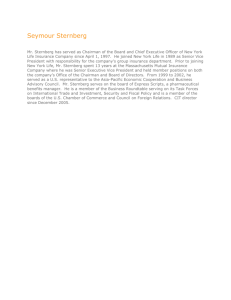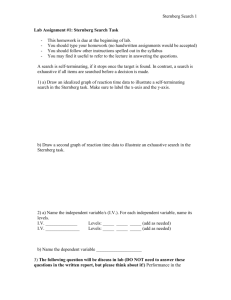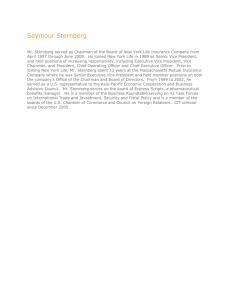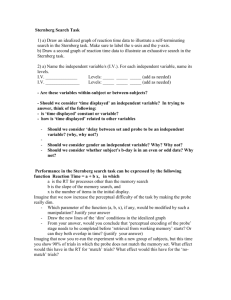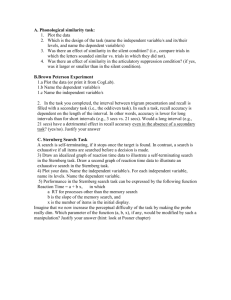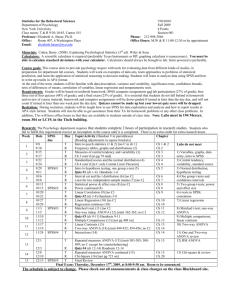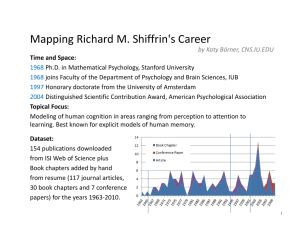PSY241 Visual Search Lab Class (version 4.11.13)
advertisement
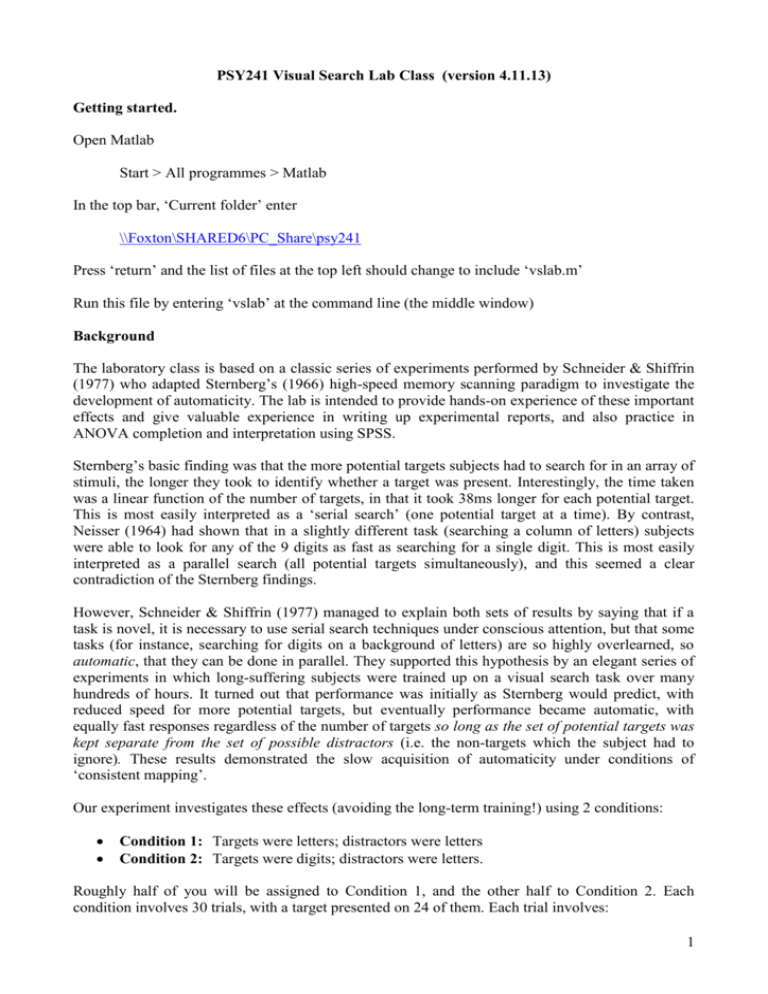
PSY241 Visual Search Lab Class (version 4.11.13) Getting started. Open Matlab Start > All programmes > Matlab In the top bar, ‘Current folder’ enter \\Foxton\SHARED6\PC_Share\psy241 Press ‘return’ and the list of files at the top left should change to include ‘vslab.m’ Run this file by entering ‘vslab’ at the command line (the middle window) Background The laboratory class is based on a classic series of experiments performed by Schneider & Shiffrin (1977) who adapted Sternberg’s (1966) high-speed memory scanning paradigm to investigate the development of automaticity. The lab is intended to provide hands-on experience of these important effects and give valuable experience in writing up experimental reports, and also practice in ANOVA completion and interpretation using SPSS. Sternberg’s basic finding was that the more potential targets subjects had to search for in an array of stimuli, the longer they took to identify whether a target was present. Interestingly, the time taken was a linear function of the number of targets, in that it took 38ms longer for each potential target. This is most easily interpreted as a ‘serial search’ (one potential target at a time). By contrast, Neisser (1964) had shown that in a slightly different task (searching a column of letters) subjects were able to look for any of the 9 digits as fast as searching for a single digit. This is most easily interpreted as a parallel search (all potential targets simultaneously), and this seemed a clear contradiction of the Sternberg findings. However, Schneider & Shiffrin (1977) managed to explain both sets of results by saying that if a task is novel, it is necessary to use serial search techniques under conscious attention, but that some tasks (for instance, searching for digits on a background of letters) are so highly overlearned, so automatic, that they can be done in parallel. They supported this hypothesis by an elegant series of experiments in which long-suffering subjects were trained up on a visual search task over many hundreds of hours. It turned out that performance was initially as Sternberg would predict, with reduced speed for more potential targets, but eventually performance became automatic, with equally fast responses regardless of the number of targets so long as the set of potential targets was kept separate from the set of possible distractors (i.e. the non-targets which the subject had to ignore). These results demonstrated the slow acquisition of automaticity under conditions of ‘consistent mapping’. Our experiment investigates these effects (avoiding the long-term training!) using 2 conditions: Condition 1: Targets were letters; distractors were letters Condition 2: Targets were digits; distractors were letters. Roughly half of you will be assigned to Condition 1, and the other half to Condition 2. Each condition involves 30 trials, with a target presented on 24 of them. Each trial involves: 1 1. The presentation of the set of targets (1, 2 or 4) (5 sec duration) 2. Presentation of up to 6 ‘slides’ of four stimuli. For each slide P. (participant) had to decide whether one of the targets was present. If so he/she pressed the spacebar, and no more slides were presented for that trial. The reaction time was measured automatically. Slides were presented for a maximum of 2 secs and so Ps had to make their decisions quickly. 3. At the end of each set of trials, the results are displayed. You now need to undertake some descriptive statistics and a 2-factor ANOVA (1-between [condition 1 or 2], 1-within [1, 2 or 4 targets]) using SPSS, with mean reaction time to correct responses as the dependent variable. This will allow you to answer the following questions: Questions to be answered: 1. Are there significant main effects of the two factors? 2. Is there a significant interaction between number-of-targets and condition? 3. You also need to estimate the ‘channel capacity’ for Condition 1 and Condition 2 by subtracting the mean time for 1 target from the mean time for 4 targets and dividing by 3 (41). This is an estimate of how long it takes to ‘process’ one elementary comparison (“is it a Q?” etc). The channel capacity is then the inverse of the processing time (so if the processing time is 0.02 seconds per operation, that’s a channel capacity of 50 operations per second, i.e. 1 / 0.02). 4. What do these effects (or lack of effects) mean for the hypotheses concerning automaticity? Is the detection of digits on letters automatic? Data Analysis 1. Enter the data into the shared google drive spreadsheet “PSY241 Visual Search Data” 2. Copy the data into your own google spreadsheet or excel file. You need to calculate the means, standard deviations and standard errors for each of the six columns Remember: you can learn a lot by doing the analysis even before all the data has been collected 3. You can then copy and paste this data into SPSS and conduct a 1-between, 1-within ANOVA. Be careful to only copy the numeric data from the table, not the column titles. Write-up Please visit the wiki and contribute to the write up of the report. Tom Stafford will provide feedback on the wiki version of the report at 4pm each day for the next two weeks, so you can view and compare the write up at different stages and see what grade each provides. Lab class tasks We know that you can complete the experimental part of the lab class well within the two hours. As with all experiments, running the experiment is only the first part. You then need to work out what it means! Please use your remaining time to practice the following things. You have available two highly experienced demonstrators who can advise you on all aspects of the experiment and write-up. Take advantage of this! 2 Summary of Lab class tasks - Generate data (i.e. do the experiment) - Enter the data - Copy to your own spreadsheet - Calculate means and standard deviations using formulas - Copy to SPSS - Run the ANOVA - Interpret any effects - Visit the wiki, and contribute to the write up. If you do not know what to write, try leaving a question for someone else to answer, or a heading for someone else to fill details in under. Original References (it is not necessary to find and read them!) Neisser, U. (1964). Visual search. Scientific American, 210, 94-102. Schneider, W. & Shiffrin, R.M. (1977). Controlled and automatic human information processing: I. Detection, search and attention. Psychological Review, 84, 1-66. Sternberg, S. (1966). High speed scanning in human memory. Science, 153, 652-654. 3 Notes for students writing up PSY241 Visual Search Lab Class Reminder on format of write-up Title Short, informative summary of the experiment Author Abstract Around 6 lines, explaining what you did and what you found Introduction Hypotheses No more than one side What were they? Method Participants Apparatus/Materials Design Procedure How many, who? Computer program, display examples What was it? Sufficient detail for someone else to replicate Results Present the descriptive statistics (mean latency + sd) for each condition, followed by the inferential statistical. Then calculate the ‘channel capacity’ for Conditions 1 and 2 Discussion Was the hypothesis supported? If not, why not? Ways the experiment might be improved. Any other relevant observations. References You should all have the set of general guidelines for writing lab reports via PSY239. Example target set (2 targets here) Example probes (always 4) – correct response is do nothing 4
